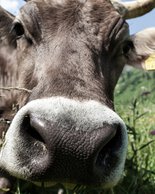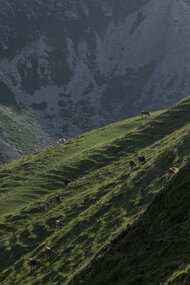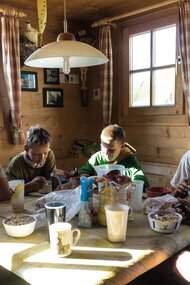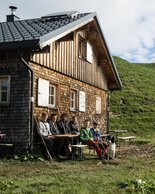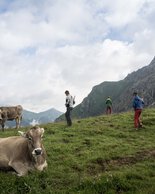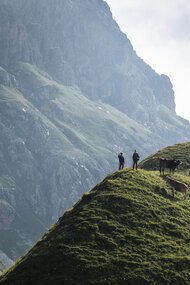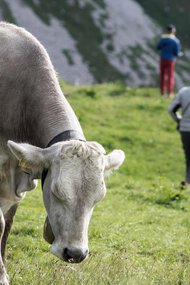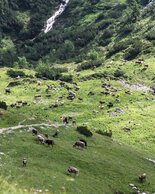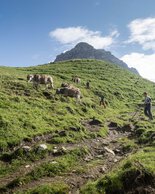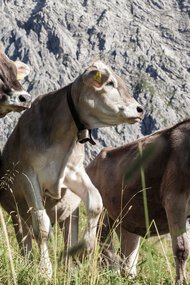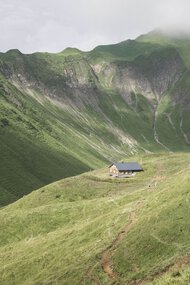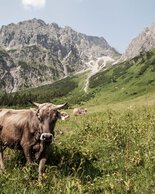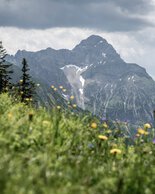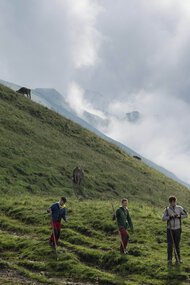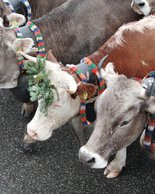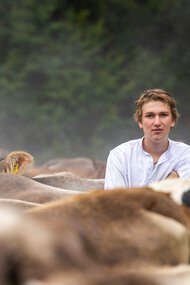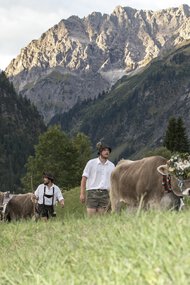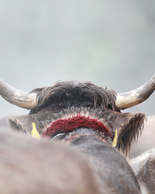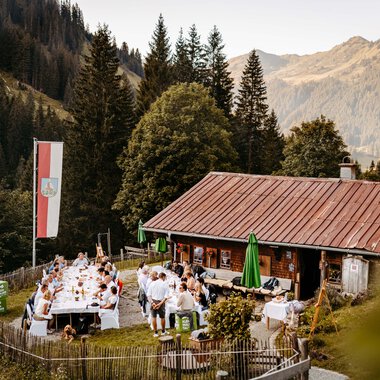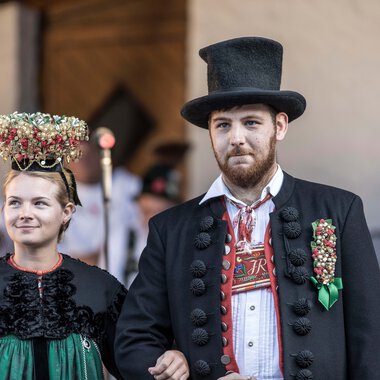Two small shepherds and their summer on the Alpe Bärgunt
29.08.2018
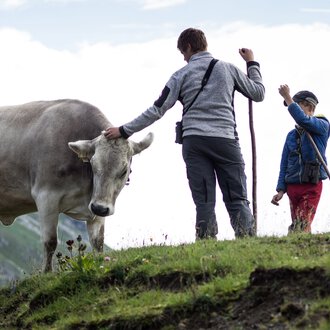
In the cities, Pokémon Go captivated many children last summer and sent them on the hunt for virtual monsters. In the Walser mountains, on the other hand, some children and teenagers spent their summer vacation as shepherds. Titus Moosbrugger (11) and Magnus Huber (12) also went back to the Alpe Bärgunt to herd the largest herd in Kleinwalsertal with 280 animals. This is Titus' fourth summer as a small herdsman and Magnus' third. We accompanied the two of them over the summer to find out why they are so passionate about life on the alp and why they voluntarily gave up the comforts of home for the simplicity of the mountains.
The first summer guests arrive
It is a cool, foggy Saturday morning in mid-June when the small shepherds around Grand Shepherd Wolfgang Ott meet for their first joint outing of the summer at the Bärgunthütte (1,408 m). Late snow and unstable weather have delayed the start of the alpine summer somewhat. But today is the arrival day. Most of their summer guests are brought to Kleinwalsertal from the Allgäu lowlands in large cattle trucks. From the parking lot in Baad, the animals are driven by their farmers and helpers towards the Bärgunthütte, the first stop on their summer retreat. There they are placed in the care of Wolfgang and his team. Titus, Magnus, Wolfgang's sons Elias and Simon and his nephew Martin make the final preparations. The sound of bells precedes the first herd and the young shepherds, equipped with their sticks, get into position. One herd after another arrives and moves into the pasture below the Bärgunthütte. There is a little anxiety in the air: the animals have to acclimatize to the large herd with its many new faces and some of them are not yet used to eating fresh grass. But there is also a slight tension in the shepherds' faces. They still don't know their charges and their peculiarities, so Titus almost ends up in the stream himself when he catches a runaway.
Shepherd with heart and tradition
Wolfgang (49) is the rock in the surf. Alpe Bärgunt has been his passion for 28 years. He is the third generation of a family of shepherds, his eye was trained from an early age and he has developed a keen sense for the animals and their different characters. He knows many of the new arrivals from last summer. The Alpe Bärgunt is one of the oldest and largest in Vorarlberg. The extensive alpine area, whose high pastures extend to just before the Widdersteinhütte (2,009 m), was first mentioned in a document 500 years ago. Since the settlement of Kleinwalsertal in the 13th century, alpine farming has been the most important source of supply for the Walser people. Old chronicles speak of the “Alpe as the farmers' breadbasket”. As tourism increased in the 1950s, alpine farming was replaced as the most important economic factor and employer. Many alps were closed down, partly because it became increasingly difficult to find young people for the strenuous work on the alp. While there were still 50 managed alps in 1945, today there are only 35 in Kleinwalsertal, whereby the livestock has of course also changed considerably and the number of dairy cows kept has fallen significantly. For Wolfgang, however, there was never an alternative. Being outdoors in summer and winter, being able to live his connection with nature and looking after the animals entrusted to him is pure happiness for him. And he is all the more pleased that a new generation of shepherds is growing up with Magnus and Titus and also in his own ranks.
real shepherd's life for four weeks
There are still two weeks to go until the eagerly awaited start of the vacations. Then the little shepherds move into the Bärgunthütte with toothbrushes, mountain boots and a few warm clothes. They sleep in the mattress dormitory. With running water and electricity, it is the more comfortable accommodation, but the highlight of the summer for Magnus and Titus are the four weeks from the end of July to the end of August on the high alp at around 2,000 meters. Several times a summer, the animals are moved to fresh pastures at higher altitudes. As soon as they get used to the terrain, it is pure relaxation for the animals, as they become fitter and more robust and strengthen their immune system through the change of air.
The fitness of the herders also improves continuously. As long as the animals stay on the pastures of the Mittelalpe, they have to get up at 6.00 a.m. every day and climb up to the cattle from the Bärgunthütte. This adds up to quite a few meters of altitude in one day. Come rain or shine, they spend the whole day with the herd. They make sure that no animal gets lost or injured, check pasture fences or lend a hand when bushes, small trees and other vegetation need to be removed from the alpine pastures to maintain their useful and protective function.
Idyll on the high alp
The penultimate Sunday in July is the day. The move to the Hochalp. It's a hot summer's day, dark clouds are already gathering at midday, but the start is not until late afternoon, because it takes a lot of helpers to drive the whole herd from the Mittelalp to the Hochalp. The trail leads through difficult terrain, which is also quite challenging for some hikers and the so-called “gesprengte Wegle” is a key section. There is no room for error on the stony, narrow path, otherwise there is a risk of falling down the rock faces below. Around 25 helpers, friends, family and neighbors have gathered together when the first drops of rain fall at 4 p.m. on the dot. While the cattle are still being rounded up from all directions and remote slopes, a group of Haflinger horses set off at a gallop. Within a very short time, they leave the steep ascent behind them and seem to disappear into the vastness of the high mountains. Gradually, the herd of cattle starts to move. The first animals voluntarily and swiftly run ahead and then the group gains momentum and moves forward quite quickly. In the meantime, however, there is no stopping the full-blown summer storm, which comes down with thunder and lightning and a never-ending downpour. Titus is one of the first groups to set off. But his hopes of getting to the hut on the Hochalp in the dry fade relatively quickly when he discovers that one of the pasture fences has given way and the animals are continuing towards the Widderstein hut. Before he can warm up and dry off in the hut, the escaped animals have to be caught and the fences straightened.
live simply, high above
Animals and humans now spend four weeks at the highest point of the Bärgunt alpine region. The young shepherds love their time on the high alp. They find that things are a little more relaxed there than on the Mittelalp. The small, cozy hut directly below the Großer Widderstein does not offer much space, a shared living room, a bedroom and the dormitory, which they share. But they seem to have everything they need. When asked if there is anything they miss up here, you are met with puzzled eyes and a mischievous smile that makes it impossible to answer.
They seem to enjoy the simplicity of life, which is based on the rhythm of the animals and nature - without any television, internet or cell phones. Hot showers are dependent on the solar panels, so it can happen that there is no hot water just when you are most looking forward to it, for example after a rainy day of herding. However, there have also been summers when the solar panels and the toilet have failed completely and they have had to make use of original alternatives.
Shepherd life up close
On the Hochalp, Wolfgang and his team are supported by Marion Edlinger and her Border Collie dog “Lea”. While Marion mainly takes care of the household chores, Lea is a trained herding dog and actively supports the shepherds in their work. At 7.00 a.m. it is still quiet, only Wolfgang is already standing in front of the hut, watching with binoculars for the herd that has spread out over the surrounding slopes. It is a mystical morning, it has rained all night, the first rays of sun are slowly breaking through the mist and the imposing Widderstein appears in the background. For the boys, the day begins at 7.30 am. Before breakfast, they fetch the two dairy cows, Bella and Frieda, and take them to be milked.
While Magnus and Titus help in the barn and clean the milking equipment again, Simon lovingly looks after a somewhat lame animal that is resting in front of the hut and Martin goes on his first round. The shepherds set off at regular intervals to count the animals and keep an eye out for suspicious tracks. Over time, they develop an eye for what to look out for and, incidentally, they become a little more independent every day. They take responsibility for the tasks entrusted to them, make their own decisions and know that the herdsman is relying on them. For Wolfgang, the animals left to him are like his own and bringing them all back to the valley in good health is a matter close to his heart.
Enjoyment in the mountains
A large part of the popular mountain tour around the Widderstein runs through the pastureland of Alpe Bärgunt. Hikers passing by the hut can rest for a moment in front of the hut and enjoy the impressive panorama and fortify themselves with a drink or yoghurt that Marion makes from the fresh milk. Marion, who actually enjoys being out and about as a shepherdess herself, is responsible for the catering. This is a gift for the men's guesthouse on the high alp, because even though the kitchen is small and the equipment is more than basic, she conjures up hearty meals every evening to round off strenuous days - a favorite of the shepherds, the Älpler tacos. After dinner, Titus and Magnus help with the washing up and tidying up, sometimes a game of pinochle is in order, but most of the time they are so tired that they like to retire to bed at nightfall.
Extremes on the high alp
If the weather cooperates, they like to jump into the lake Hochalpse between their control rounds. But it has to be a really hot summer for that. Instead, this year there was even a small onset of winter in mid-August, a precarious situation for cattle and shepherds. Although the snow soon melts again, the steep slopes can initially become a dangerous slippery slope for the animals. At such times, the young shepherds benefit from Wolfgang's decades of experience. Moving cattle, especially in such adverse conditions, takes skill and a good dose of intuition to recognize which path to choose and how to position yourself to move the animals safely from one place to another. The deadline for the move back to the lower camp is August 24th, St. Bartholomä, and so on the penultimate Sunday in August the whole team of helpers meets again to bring the animals back to the Mittelalpe.
The grand finale - the Alpine cattle drive
The summer vacations are drawing to a close, and Titus and Magnus return home a week before school starts and slowly get used to life in the valley again. After a long bath and extended moments of relaxation on the sofa at home, the moms decide that a visit to the hairdresser is urgently needed for their returning sons. Wolfgang's Alpine beard, on the other hand, will stay on at least until the cattle drive on September 19. The cattle are now grazing again on the pastures near the Bärgunthütte. The day before the cattle drive, all the helpers gather again and their anticipation of the special event is palpable.
Of course, Magnus and Titus also come to the last big event of the alpine summer to exchange the animals' bells for the melodious bells. The bells belong to herdsmen and farmers and primarily have an emotional meaning for their owners, but depending on their size and workmanship, they are worth up to € 600. The small shepherds now also know each of the animals and can tell them apart based on their external features and individual characters. The cattle from a total of 15 farmers will return to their home stables tomorrow.
Returning home with pride
Shortly after sunrise the next day, they set off with the whole herd and drive them from the Bärgunthütte to the Scheidplatz in Riezlern, where the animals are separated and received by their owners. Everything went well until the last day, and Wolfgang is proud that he can bring all the animals back to each farmer in good health. Most of them have entrusted him with their livestock for many years and friendships have developed that he values highly. When all the animals return to the valley in good health, the procession is led by an elaborately decorated wreath of cattle.
As the herd at Alpe Bärgunt comprises well over 200 animals, there are actually two of them. But it's not just the cattle that are dressed up for this special day, the herdsmen also put on their Sunday best and look forward to rounding off a successful alpine summer after the last strenuous endurance run from Baad to Riezlern. As a thank you for their efforts, the small herdsmen receive pocket money from the Alpe Bärgunt and a bell, which is elaborately engraved with their name and the year of the alpine summer. A valuable memento of a summer that has given them so many experiences and adventures that will probably stay with them for the rest of their lives.

